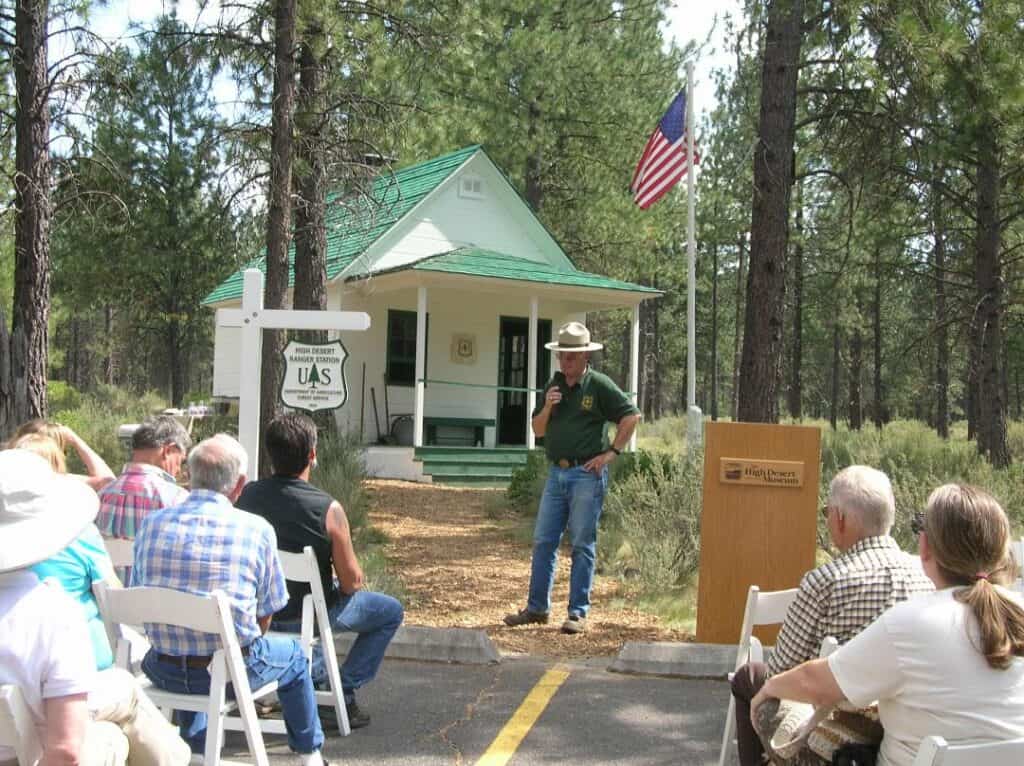
“I like a Ranger Station in white and green occasionally instead of all that tobacco-brown we go in for so much,” the forest supervisor of the fictitious Ponderosa National Forest commented to
the ranger of its fictitious Barlow Ranger District in George R. Stewart’s 1949 novel Fire.
When the dust cleared, I stood alone by U.S. Highway 395, squinting after the Greyhound bus rapidly disappearing to the southeast. A broad grassy valley, rimed by sagebrush-covered slopes
studded with pinyon and juniper, shimmered in the brilliant sunlight of a June afternoon. A light, fresh breeze carried the scents of grass, sagebrush, and pine. An occasional unfamiliar bird call broke the silence.
And, across the highway, a small brown sign promised I would find the Bridgeport Ranger Station just beyond a slight rise. I shouldered my sea bag and crossed the highway toward whatever that promise held. That turned out to be five summers in wildfire prevention and control that saw me through college and into the Navy.
About fifty yards along the dirt road, I topped the rise and saw it: a ranger station in white and green! Just like in Stewart’s novel! Gravel crunched beneath my boots as I strode toward a small building marked “office” flanked by an antenna.
Four decades later, during a kitchen table conversation with Bob Boyd, then Curator of Western History at the High Desert Museum south of Bend, Oregon, two ideas were hatched. The first, for a U.S. Forest Service centennial exhibit at the Museum, was realized when “A Century of Service: The U.S. Forest Service on the High Desert” opened in June 2005 for a two-year run.
The second idea took a little longer.
Bob mentioned the Museum’s evolving plan for outdoor interpretation of the relationships between life and natural resources in the Intermountain West, the Museum’s interpretive turf. This would include a small, old-time U.S. Forest Service ranger station. He was interested in “a little old Forest Service building out in the middle of Nevada that might be available” for this purpose.
“Is it on the Toiyabe National Forest?” I asked.
“Yes.”
“Is it south of Austin on the Reese River?” I asked.
“Yes.”
“I know the building!” I exclaimed. It was the one-room 1933 Bridgeport Ranger Station office building in which I’d signed on for my first Forest Service job in June 1962. Later that year, it had been moved to the later-abandoned Reese River Ranger Station—another old ranger station in white and green—forty miles south of Austin where the district ranger needed an office. A new, modern, “tobacco brown” office building had replaced the white and green office building of my first Toiyabe summer.
Bob and I had a project! I reconnoitered the structure in September 2004 and found it sound and moveable. Bob and I visited the structure in March 2006 to further evaluate it and begin serious negotiations with the Forest Service for its acquisition. We began working with the Humboldt-Toiyabe National Forest (the two Nevada national forests had been consolidated) and the Intermountain Region of the National Forest System to acquire the historic ranger station office structure to serve as the centerpiece of the planned exhibit.
Projects cost money. Most of that came from the Pacific Northwest Forest Service Association of retired Forest Service people as both an organization and as individuals who sponsored the effort.
By early 2008, with the assistance of officials in the Forest Service and other concerned agencies, approval for transfer of the structure to the High Desert Museum on a “long-term loan”
basis was secured. Bob and I spent four days in March 2008 making on-site preparations for moving it 550 miles north to the Museum. We returned with a couple others in June to complete
the process that culminated in the structure’s arrival at the Museum at 11:00 a.m. on June 26, 2008, and its initial restoration in white and green completed on August 2, 2008.
Restoration—internal as well as external—continued through spring 2009 to prepare it for a gala dedication on June 30. Beginning the next day, Bend area Forest Service retirees George Chesley, Dick Connelly, and Stan Kunzman joined me in staffing what is called the High Desert Ranger Station every day through Labor Day. The four of us welcomed hundreds of High Desert Museum visitors with whom we shared the story of forest rangers who worked out of stations such as this to manage the resources of the National Forest System for the benefit of the people of the United States.
This has continued with strong volunteer teams every summer since. “What were all those ranchers and farmers and miners and loggers whose stories the High Desert Museum tells so well doing as the Old West became the New West?” we ask visitors. “Building a civilization based on natural resources. Forest rangers working from ranger stations such as this helped to sustain the natural resources on which the West’s economy continues to evolve and thrive,” is the answer we’re fishing for and provide.
To this day, every time Bob and I see each other, we share “We did it!” grins.

What a wonderful story. None of the stations that I worked out of were as colorful but the tale brings back many memories. Thanks!
Mac
Reminds me of the Animas Ranger Station on the San Juan NF just north of Durango. A one room building with a wood stove in the middle of the room. My first formal position. Three of us shared the space: Ranger, Asst’t. Ranger and Forester (me). The Manual and Handbooks cover the side of a wood table. No facilities. The Ranger house was behind the Station. Office was moved to the upper level of the Post Office and the land sold, likely for a fancy house.